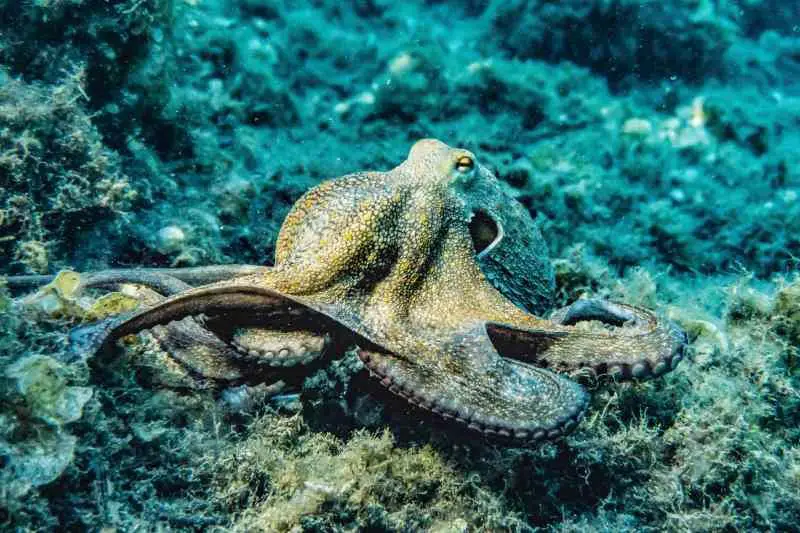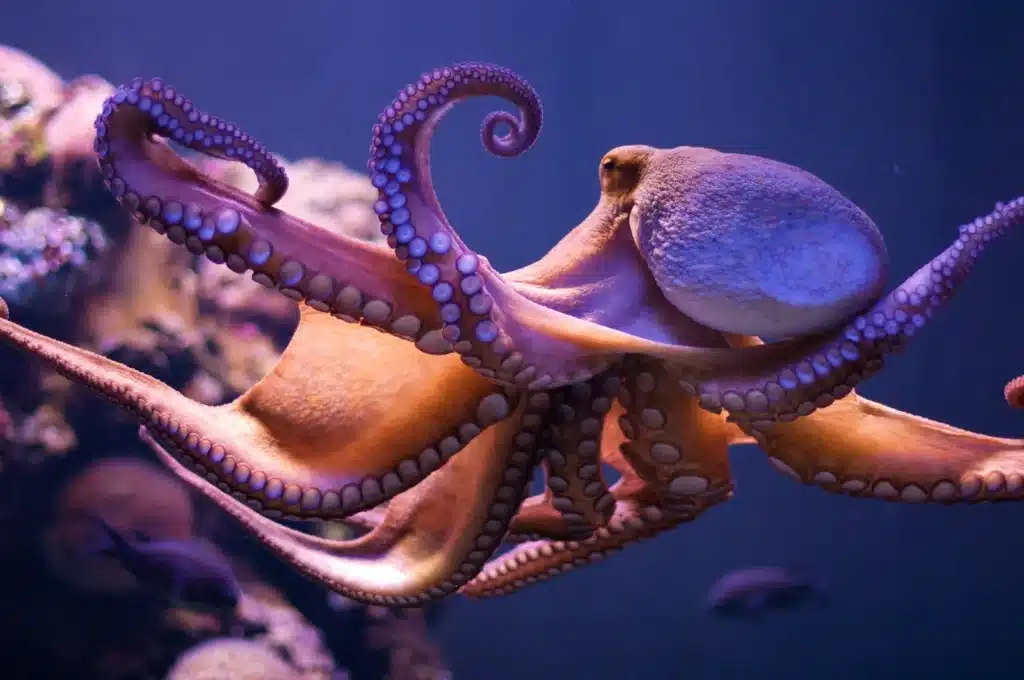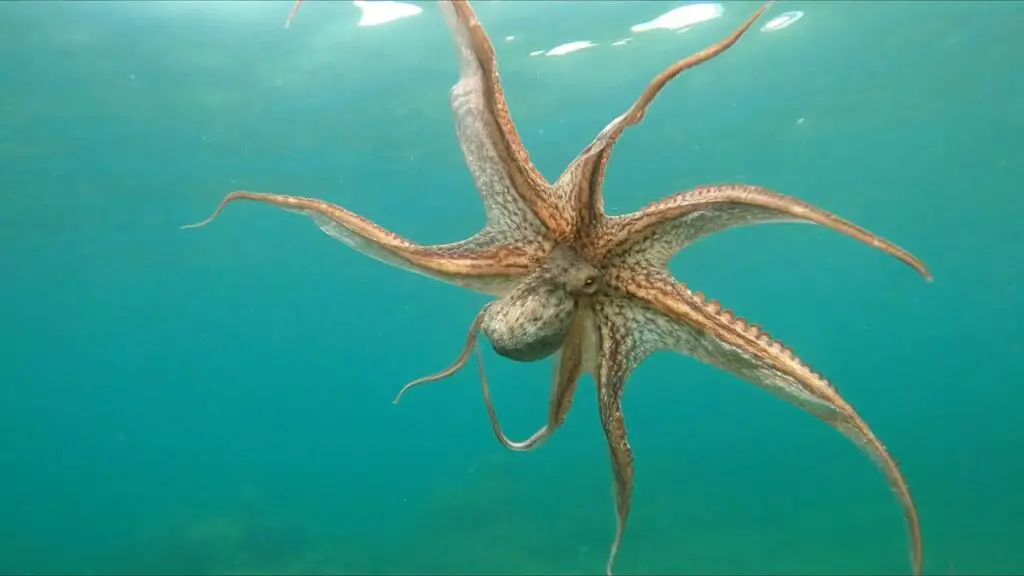Can Octopus Grow Back Limbs

Introduction
Can Octopus Grow Back Limbs: The octopus, a fascinating and enigmatic creature of the ocean, has long captured the imagination of scientists and laypeople alike. With its intelligence, shape-shifting abilities, and complex behaviors, the octopus is a subject of ongoing scientific inquiry. Among the many intriguing aspects of octopus biology is their remarkable ability to regenerate lost limbs.
Unlike most vertebrates, which struggle to repair or regrow damaged appendages, octopuses possess a unique capacity for regeneration. When an octopus loses an arm to predation, injury, or even deliberate self-amputation, it has the astonishing ability to regrow the missing limb. This ability extends beyond mere healing; it encompasses the complete reconstruction of complex structures, including the intricate sucker-covered arms that define an octopus.
The process of limb regeneration in octopuses raises numerous questions for researchers. How do they initiate the regrowth? What cellular and molecular mechanisms are involved? Are there limitations to this regenerative power? Understanding these processes could have profound implications for regenerative medicine and inspire new approaches to treating injuries and diseases in humans.
In this exploration of octopus limb regeneration, we delve into the mechanisms, mysteries, and potential applications of this remarkable natural phenomenon. By unlocking the secrets of the octopus’s regenerative prowess, we may uncover valuable insights into the broader field of regenerative biology and, ultimately, the human quest for tissue regeneration.

How long does it take for an octopus limb to grow back?
From being able to regenerate an entirely new arm in just 2-4 months to having mini-brains in each arm to being able to smell, taste, and sense light, octopus arms are just one more topic we can all geek out about!
The regrowth of an octopus limb is a remarkable process that raises questions about its timeline and efficiency. While the exact duration can vary depending on factors like the octopus’s age, health, and environmental conditions, it generally takes several weeks to several months for an octopus to fully regenerate a lost limb.
The process typically begins with the formation of a specialized structure known as a “regeneration bud” at the site of the missing arm. This bud gradually develops into a small, rudimentary limb, which then undergoes extensive growth and remodeling. The rate of regeneration is influenced by factors such as the octopus’s access to food, water temperature, and genetic factors.
Younger octopuses tend to regenerate limbs more quickly than older ones, as they possess greater regenerative potential. Additionally, a well-nourished octopus with a balanced diet is likely to regenerate more rapidly than one experiencing food scarcity.
The intricacies of octopus limb regeneration continue to be a subject of scientific research, offering insights into the broader field of regenerative biology. Understanding the time frame of this process is not only a testament to the octopus’s incredible resilience but also holds promise for potential applications in regenerative medicine for humans, where the pace of tissue regrowth remains a significant challenge.
How do octopus regrow limbs?
Cells called hemocytes flood the place where the arm was lost, and then regenerating fibers start growing into what will become a brand-new, fully functioning arm! This study took a close look at the process of arm regeneration in a Common Octopus (Octopus vulgaris).
The process by which octopuses regrow their limbs is a testament to the marvels of natural regeneration. Unlike many vertebrates, which struggle to regenerate lost appendages, octopuses possess a unique set of mechanisms that allow them to regrow their limbs with remarkable precision.
The regrowth of octopus limbs typically begins with the formation of a specialized structure known as a “regeneration bud” at the site of the missing arm. This bud is a cluster of undifferentiated cells with the potential to develop into various tissue types. Within this bud, a complex interplay of cellular processes unfolds.
Cell division and differentiation are the key drivers of limb regeneration. Stem cells within the regeneration bud divide rapidly, generating a population of cells that will give rise to the various tissues needed for the new limb. These cells then differentiate into specialized cell types, such as muscle, nerve, and skin cells, following a carefully orchestrated genetic program.
The intricate genetic and molecular signaling pathways governing this process are still the subject of ongoing research. Understanding the cellular and molecular mechanisms behind octopus limb regeneration not only sheds light on their remarkable abilities but also holds promise for advancements in regenerative medicine for humans.
Do octopus legs grow back if you cut them off?
While cut-off limbs do not regrow a new octopus, à la starfish, the octopus can regenerate tentacles with a far superior quality than, say, a lizard’s replacement tail, Harmon writes. To do this, octopus use a protein called protein acetylcholinesterase, or AChE.
Octopus legs can indeed grow back if they are severed or amputated. This regenerative ability is one of the most intriguing aspects of octopus biology and sets them apart from many other animals, including humans.
When an octopus loses a leg, it initiates a complex and fascinating process of regeneration. At the site of the injury, a structure called a “regeneration bud” forms. This bud consists of undifferentiated cells that have the potential to develop into various types of tissues, such as muscle, skin, and nerves.
Over time, these cells undergo rapid division and specialization, following a precise genetic program. This process allows the limb to regrow, ultimately restoring the octopus’s full complement of arms.
The rate of regeneration can vary among octopuses and depends on factors such as the individual’s age, overall health, and environmental conditions. Younger octopuses tend to regenerate limbs more quickly, and a well-nourished octopus is likely to regrow its leg faster than one with limited access to food.
The incredible regenerative capabilities of octopuses continue to be a subject of scientific research, offering insights into the broader field of regenerative biology. Understanding this process could have significant implications for regenerative medicine and inspire innovative approaches to healing and tissue regeneration in humans.
What happens when an octopus loses one of its arms?
Rare is the octopus with fewer than eight—at least partial—arms. Because as soon as an arm is lost or damaged, a regrowth process kicks off to make the limb whole again—from the inner nerve bundles to the outer, flexible suckers.
When an octopus loses one of its arms, it triggers a remarkable series of events in the creature’s life. Octopuses are well-known for their ability to regenerate lost limbs, and this process is set into motion immediately upon arm loss.
The first response is often a deliberate act on the octopus’s part. It can perform autotomy, a process of self-amputation, where it will intentionally detach the damaged or threatened arm to escape from predators or dangerous situations. This self-inflicted arm loss is a survival strategy that allows the octopus to make a quick getaway while the attacker is left holding onto a limb.
Once the arm is severed, the octopus begins the regeneration process. At the site of the amputation, a specialized structure called a “regeneration bud” forms. This bud contains undifferentiated cells that have the potential to develop into various tissue types, including muscle, skin, and nerves. Over time, these cells undergo rapid division and specialization, guided by intricate genetic and molecular mechanisms.
The regeneration process can take several weeks to months, depending on various factors, such as the octopus’s age, health, and environmental conditions. The newly regrown arm eventually becomes fully functional, complete with the characteristic suckers and intricate appendage structure that defines an octopus.
The ability to regenerate lost limbs is a testament to the octopus’s adaptability and resilience, making it a fascinating subject of study in the field of regenerative biology.
What happens if an octopus loses a leg?
When threatened (or when mating), an octopus might detach its own arm and swim away. It then regrows the arm using undifferentiated stem cells that then specialize into the various cell types needed to build a new arm.
When an octopus loses one of its legs, it initiates a remarkable process of regeneration. This ability sets octopuses apart from many other animals and showcases their extraordinary capacity for self-repair.
The process of leg regeneration begins with the formation of a specialized structure known as a “regeneration bud” at the site of the missing limb. This bud contains undifferentiated cells capable of developing into various types of tissues, including muscle, skin, and nerves. These cells undergo rapid division and specialization, guided by complex genetic and molecular signaling.
Over time, the regeneration bud grows and differentiates, eventually developing into a fully functional octopus leg. The regenerated leg typically looks and functions much like the original, complete with the characteristic suckers that allow the octopus to manipulate objects and capture prey.
The timeline for leg regeneration can vary among individual octopuses and depends on factors such as their age, overall health, and environmental conditions. Younger octopuses tend to regenerate limbs more rapidly, and those with access to ample food resources often exhibit quicker regrowth.
The incredible regenerative capabilities of octopuses continue to be a subject of scientific fascination, offering valuable insights into the broader field of regenerative biology. Understanding how octopuses regenerate their legs may inspire innovative approaches to tissue regeneration and healing in humans, where such abilities are much more limited.
How do octopuses regenerate their limbs?
Octopuses have an astonishing ability to regenerate their limbs, a process that sets them apart from many other animals. The mechanism behind octopus limb regeneration is a complex interplay of cellular and molecular processes.
When an octopus loses a limb, whether through predation, injury, or self-amputation, it triggers a regenerative response. At the site of the missing limb, a specialized structure called a “regeneration bud” forms. This bud consists of undifferentiated cells, often referred to as pluripotent stem cells, which have the remarkable capacity to develop into various tissue types.
These stem cells within the regeneration bud rapidly divide and differentiate, guided by a precise genetic program. Over time, they transform into specialized cells, including muscle, skin, and nerve cells, necessary to reconstruct the intricate anatomy of the lost limb.
The genetic and molecular signaling pathways governing this process are still the subject of ongoing research, as scientists seek to unravel the secrets of octopus limb regeneration. Understanding the intricacies of this natural phenomenon not only provides insights into the remarkable adaptability of octopuses but also holds potential for applications in regenerative medicine for humans, where such regenerative abilities are limited.
Octopuses regenerate their limbs through the activation of pluripotent stem cells within a regeneration bud, which undergo controlled differentiation to rebuild the lost appendage, showcasing nature’s extraordinary capacity for self-repair and adaptation.
Are there any limitations to octopus limb regeneration?
While octopuses possess an impressive ability to regenerate lost limbs, there are indeed limitations to this remarkable process. Despite their extraordinary regenerative capabilities, octopuses don’t have unlimited regrowth potential, and several factors can influence the extent and success of limb regeneration.
- Age: Younger octopuses tend to regenerate limbs more efficiently than older ones. As they age, their regenerative abilities may decline.
- Health and Nutrition: Octopuses in poor health or those with limited access to food resources may experience slower or less successful limb regeneration. Adequate nutrition is crucial for supporting the energy-intensive process of regrowth.
- Environmental Conditions: Water temperature and environmental stressors can impact regeneration. Octopuses in suboptimal conditions may experience delays or abnormalities in limb regrowth.
- Injury Severity: The extent of the injury plays a role. While octopuses can regenerate entire arms, severe injuries that damage the central nerve cord or other critical structures may hinder or prevent successful regeneration.
- Number of Regenerations: Octopuses may have a finite number of regenerations in their lifetime. Repetitive limb loss and regeneration can potentially deplete their regenerative capacity over time.
- Regenerated Limb Quality: Regenerated limbs may not be identical to the original, and their functionality can vary. Some may have minor deformities or reduced functionality.
Despite these limitations, octopuses’ ability to regenerate limbs remains an exceptional example of nature’s adaptability and resilience. Understanding these limitations can provide valuable insights into the mechanisms of regeneration and may inspire research to overcome similar challenges in the field of regenerative medicine for humans.
Do all octopus species have the same regenerative abilities?
While the general capability to regenerate lost limbs is a shared trait among many octopus species, the extent and efficiency of regeneration can vary significantly.
The regenerative potential of an octopus species depends on various factors, including its genetic makeup, environmental conditions, and evolutionary history. Some species exhibit robust and rapid limb regeneration, while others may have more limited regenerative abilities.
For example, some studies suggest that younger octopuses tend to regenerate limbs more efficiently than older ones, and this variation can be observed among different species. Additionally, environmental factors such as water temperature and the availability of food resources can influence the regenerative capacity of octopuses.
The specific mechanisms and genetic pathways governing regeneration may vary among octopus species. Scientists are continually researching these differences to gain a deeper understanding of the genetic and molecular underpinnings of regeneration in cephalopods.
While limb regeneration is a fascinating and widespread phenomenon among octopuses, the regenerative abilities can differ from species to species. These variations provide valuable insights into the diversity of life’s adaptations in the fascinating world of cephalopods.

Conclusion
In the realm of biological wonders, the octopus stands as a testament to nature’s capacity to surprise and inspire. The ability of these cephalopods to regrow lost limbs represents an extraordinary feat of regeneration that continues to captivate the scientific community and the public alike.
Through our exploration of octopus limb regeneration, we have unveiled the intricacies of this remarkable phenomenon. The process involves a complex interplay of cellular mechanisms, signaling pathways, and genetic factors that orchestrate the regrowth of intricate, sucker-laden arms. Understanding these processes could offer invaluable insights into regenerative biology, providing potential solutions to long-standing challenges in human medicine.
Octopuses, as masters of adaptability and resilience, showcase the possibilities of regenerative medicine. By deciphering the secrets of their regenerative prowess, we may pave the way for innovative treatments for traumatic injuries, degenerative diseases, and congenital anomalies in humans. This research may one day empower us to unlock the dormant regenerative potential within our own bodies.
The octopus’s ability to regrow limbs is not merely a biological curiosity; it is a source of inspiration for scientists and dreamers alike. It serves as a reminder that the natural world is full of surprises and lessons, urging us to continue exploring, learning, and pushing the boundaries of our understanding.



